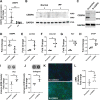Targeted regulation of fibroblast state by CRISPR-mediated CEBPA expression
- PMID: 31829168
- PMCID: PMC6907247
- DOI: 10.1186/s12931-019-1253-1
Targeted regulation of fibroblast state by CRISPR-mediated CEBPA expression
Abstract
Background: Fibroblasts regulate tissue homeostasis and the balance between tissue repair and fibrosis. CCAAT/enhancer-binding protein alpha (CEBPA) is a key transcription factor that regulates adipogenesis. CEBPA has been shown to be essential for lung maturation, and deficiency of CEBPA expression leads to abnormal lung architecture. However, its specific role in lung fibroblast regulation and fibrosis has not yet been elucidated.
Methods: Lung fibroblast CEBPA expression, pro-fibrotic and lipofibroblast gene expression were assessed by qRT-PCR. CEBPA gain and loss of function experiments were carried out to evaluate the role of CEBPA in human lung fibroblast activation with and without TGF-β1 treatment. Adipogenesis assay was used to measure the adiopogenic potential of lung fibroblasts. Finally, CRISPR activation system was used to enhance endogenous CEBPA expression.
Results: We found that CEBPA gene expression is significantly decreased in IPF-derived fibroblasts compared to normal lung fibroblasts. CEBPA knockdown in normal human lung fibroblasts enhanced fibroblast pro-fibrotic activation and ECM production. CEBPA over-expression by transient transfection in IPF-derived fibroblasts significantly reduced pro-fibrotic gene expression, ECM deposition and αSMA expression and promoted the formation of lipid droplets measured by Oil Red O staining and increased lipofibroblast gene expression. Inhibition of the histone methyl transferase G9a enhanced CEBPA expression, and the anti-fibrotic effects of G9a inhibition were partially mediated by CEBPA expression. Finally, targeted CRISPR-mediated activation of CEBPA resulted in fibroblasts switching from fibrogenic to lipofibroblast states.
Conclusions: CEBPA expression is reduced in human IPF fibroblasts and its deficiency reduces adipogenic potential and promotes fibrogenic activation. CEBPA expression can be rescued via an inhibitor of epigenetic repression or by targeted CRISPR activation, leading to reduced fibrogenic activation.
Keywords: Adipogenesis; CEBPA; CRISPR activation; Fibroblast activation; Lipofibroblast; Lung fibrosis.
Conflict of interest statement
The authors declare that they have no competing interests.
Figures





Similar articles
-
Interplay between EZH2 and G9a Regulates CXCL10 Gene Repression in Idiopathic Pulmonary Fibrosis.Am J Respir Cell Mol Biol. 2018 Apr;58(4):449-460. doi: 10.1165/rcmb.2017-0286OC. Am J Respir Cell Mol Biol. 2018. PMID: 29053336 Free PMC article.
-
Spontaneous Lung Fibrosis Resolution Reveals Novel Antifibrotic Regulators.Am J Respir Cell Mol Biol. 2021 Apr;64(4):453-464. doi: 10.1165/rcmb.2020-0396OC. Am J Respir Cell Mol Biol. 2021. PMID: 33493091 Free PMC article.
-
TGF-β1 epigenetically modifies Thy-1 expression in primary lung fibroblasts.Am J Physiol Cell Physiol. 2015 Nov 1;309(9):C616-26. doi: 10.1152/ajpcell.00086.2015. Epub 2015 Sep 2. Am J Physiol Cell Physiol. 2015. PMID: 26333597 Free PMC article.
-
Wilms Tumor 1-Driven Fibroblast Activation and Subpleural Thickening in Idiopathic Pulmonary Fibrosis.Int J Mol Sci. 2023 Feb 2;24(3):2850. doi: 10.3390/ijms24032850. Int J Mol Sci. 2023. PMID: 36769178 Free PMC article. Review.
-
3D in vitro hydrogel models to study the human lung extracellular matrix and fibroblast function.Respir Res. 2023 Oct 5;24(1):242. doi: 10.1186/s12931-023-02548-6. Respir Res. 2023. PMID: 37798767 Free PMC article. Review.
Cited by
-
Transcriptional analysis of lung fibroblasts identifies PIM1 signaling as a driver of aging-associated persistent fibrosis.JCI Insight. 2022 Mar 22;7(6):e153672. doi: 10.1172/jci.insight.153672. JCI Insight. 2022. PMID: 35167499 Free PMC article.
-
Fatty Acid Metabolism and Idiopathic Pulmonary Fibrosis.Front Physiol. 2022 Jan 14;12:794629. doi: 10.3389/fphys.2021.794629. eCollection 2021. Front Physiol. 2022. PMID: 35095559 Free PMC article. Review.
-
Quantitative Proteomic Analysis Reveals the Mechanisms of Sinapine Alleviate Macrophage Foaming.Molecules. 2023 Feb 21;28(5):2012. doi: 10.3390/molecules28052012. Molecules. 2023. PMID: 36903257 Free PMC article.
-
The CEBPA-FGF21 regulatory network may participate in the T2DM-induced skeletal muscle atrophy by regulating the autophagy-lysosomal pathway.Acta Diabetol. 2023 Nov;60(11):1491-1503. doi: 10.1007/s00592-023-02131-x. Epub 2023 Jul 1. Acta Diabetol. 2023. PMID: 37392202
-
TRβ activation confers AT2-to-AT1 cell differentiation and anti-fibrosis during lung repair via KLF2 and CEBPA.Nat Commun. 2024 Oct 7;15(1):8672. doi: 10.1038/s41467-024-52827-z. Nat Commun. 2024. PMID: 39375377 Free PMC article.
References
MeSH terms
Substances
Grants and funding
LinkOut - more resources
Full Text Sources
Research Materials

